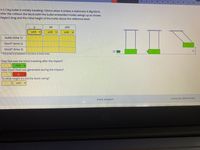Question

Transcribed Image Text:50
51
52
53
54
55
56
57
58
59
61
A 0.12kg bullet is initially traveling 120m/s when it strikes a stationary 4.3kg block.
After the collision the block (with the bullet embedded inside) swings up as shown.
Neglect drag and the initial height of the bullet above the reference level.
KE
GPE
unit
unit
unit
bullet (time 1)
block* (time 2)
block* (time 3)
h
* The bullet is embedded in the block at these times.
How fast was the block traveling after the impact?
m/s
How much heat was generated during the impact?
To what height (h) did the block swing?
unit
check answers
cannot be determined
Expert Solution
This question has been solved!
Explore an expertly crafted, step-by-step solution for a thorough understanding of key concepts.
This is a popular solution
Trending nowThis is a popular solution!
Step by stepSolved in 3 steps

Knowledge Booster
Similar questions
- The speed of the fastest-pitched baseball was 43.0 m/sm/s , and the ball's mass was 145 gg . For related problem-solving tips and strategies, you may want to view a Video Tutor Solution of Preliminary analysis of a collision. 1.What was the magnitude of the momentum of this ball? 2.How many joules of kinetic energy did this ball have? 3.How fast would a 60.0 gram ball have to travel to have the same amount of kinetic energy? 4.How fast would a 60.0 gram ball have to travel to have the same amount of momentum?arrow_forwardA small, 150 g cart is moving at 1.70 m/s on a frictionless track when it collides with a larger, 5.00 kg cart at rest. After the collision, the small cart recoils at 0.890 m/s. Part A What is the speed of the large cart after the collision? Express your answer with the appropriate units. V= 00 Submit μA Value Request Answer Units ?arrow_forwardThe figure below shows the velocity-versus-time graph before and after the collision of two carts on a horizontal track. After the collision the carts stick together. Green and blue lines show the velocities of cart 1 and cart 2, respectively, before the collision. The black line shows the velocity of the carts joined together after the collision. Determine the ratio of the carts' masses ml/m2. 0 VIX V2x collisionarrow_forward
- Ted Cmass=4Okg) and fredCmass = 60kg)are Stationary on frictionless ice, as seen in the drauing Poelow. Fredis holding a 10kg medicine ball. Fred throws it at 5mls to Ted who catches it. Ted throws the ball back to Fred at 7m/s, and Fred Catches it Ted D→Fred a) what is Ted's speed after catching the ball and throwing it back to Ered? b)What is Fred's speed after catching the ball thrown' from Ted?arrow_forwardA mass ma = 2kg slides down slippery ramp, reaching a speed v = 10 m/s at the bottom. After reaching the level ground ma collides with mass mg = perfectly inelastic collision. 3kg at bottom, sticking together in a a.) What was the height of the ramp, assuming that m, started from rest? b.) How fast were the combined masses ma and mg moving after sticking together? c.) The combined mass runs into a spring, which brings it to a stop after being compressed 7 cm. What is the spring constant k ?arrow_forwardA 800 kg cart is rolling to the right at 1.10 m/s. A 70.0 kg man is standing on the right end of the cart. Part A What is the speed of the cart if the man suddenly starts running to the left with a speed of 8.00 m/s relative to the cart? Express your answer with the appropriate units. μA Value Submit Units Request Answer ?arrow_forward
- Car Striking a A 1000 kg vehicle traveling at 30 m/s smashes into a tree and comes to rest as shown. The front of the car is compressed a distance of 0.3 m. What is the time interval, At of the collision? (Assume the net force exerted by tree on the car is constant over time interval) A. 1.00 s B. 0.20 s C. 0.10 s D. 0.02 s E. 0.01 sarrow_forwardSC 24: Module 4 Assignment Booklet 48 For questions 17 to 21, read each question carefully. Decide which of the choices BEST answers the question. Place your answer in the blank space given. 17. Two vehicles with the same mass and travelling the same speed in opposite directions hit head on. What is the total momentum immediately after the collision? A. zero B. double that of each car C. one half that of each car D. four tirnes that of each car Use the following diagram to answer questions 18 and 19. Car B Car A nt Bookl ence 24arrow_forward6. A 2.0 kg bag is held by a string to the ceiling as shown in the diagram below. A 10 g bullet strikes the stationary bag. The speed of the bag and bullet after the collision is 0.80 m/s. Assuming there is no friction, determine the maximum height of the bag after the collision. Please hand write it, clearly.arrow_forward
arrow_back_ios
arrow_forward_ios